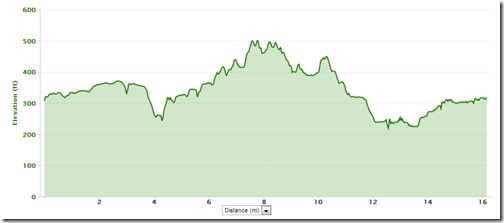 When it comes to training effectively, running hard during workouts is the easy part. The trick is structuring your training weeks (and entire program) so that you have the right balance of hard work and adaptation/recovery.
When it comes to training effectively, running hard during workouts is the easy part. The trick is structuring your training weeks (and entire program) so that you have the right balance of hard work and adaptation/recovery.
In my last post, I talked about the reasons why runners should vary their pacing from day to day. In this update, I’ll provide a simple way to think about structuring training weeks, so that you can apply pacing variation to get the most out of your body.
A Training “Week” Does Not Always Equal 7 Days
The first step in determining how to structure your training weeks is to figure out how much recovery time you need between hard workouts. This varies greatly from runner to runner, though there are a few general approaches that work quite well. Two of them use a traditional 7-day week, and the other uses 9 or 10 days per training “week.”
1. The Traditional Week: You’ll note that most “stock” training plans that you can download or purchase online feature 3 “quality” days per week (usually a workout on Tuesday, a workout on Thursday, and a long run over the weekend). This is the most common training week used by recreational runners, and for people with jobs and families, as well as for younger runners, this is the best fit. When using this approach, I only schedule 2 strenuous sessions and use the 3rd workout as a moderate/support day. If you use the traditional approach, either do (a) Hard workout Tuesday, moderate workout Thursday, long run with some speed mixed in; or (b) Hard workouts Tuesday and Thursday, steady SLOW long run. If you are using this approach and find that you feel flat or tired for your workouts, then switching to one of the other options can help you.
2. The Single Workout Week: Depending on the specifics of a cycle, I will mix in a 1-workout week for my runners, even if they are on a traditional schedule. In this approach, the long run stays on Saturday/Sunday, but the weekdays feature one hard session, usually on Wednesday. This allows you to run hard during your Wednesday workout, but still have time to recover before the weekend long run. I like this approach as a standard for many masters runners (who need more adaptation time in general), or for the later-cycle weeks in a race buildup where the workouts are taxing and specific (i.e. long tempo runs, long intervals, etc.).
3. The Expanded Week: Another approach that can be very successful, and one that you will see used more frequently by elite athletes that don’t need to fit in long runs on the same day each week, is the 9-day or 10-day training “week.” Within this block of days, three workouts are generally targeted (one of them being a long run). This allows for two or three days of adaptation between all hard efforts, in an effort to allow for better recovery and more leeway to attack workouts. This can also be a great approach for runners who require more recovery time in general (older runners, and beginners).
In general, the key is understanding that a training week can be different for various runners, or various training situations.
Most of Your Training Should Be Easy
Once you’ve determined the general structure for quality days, you are left with the majority of the week to fill with other training. This is usually the process I go through when planning a week for a client: Add key workouts first, then fill in the remainder with easy miles, cross-training, or rest.
It’s important to note that active recovery can come in the form of recovery/easy running, or cross training, and in both cases, you will be improving your general aerobic fitness. You can be a successful runner, depending on your experience and level, with anywhere from 3-7 days a week of running. On the other days, the focus should be very easy training, to maintain your base of fitness and encourage adaptation in between hard workouts.
Variability is the Key; One Week Should Not Look Like the Next
Your weekly plan should always be completed in the context of what came before, and what will come after. The main thing to remember is that your body adapts to new stimuli more effectively than it does to repeated stimuli. So, when you plan your workouts, make sure that you vary the approach. This means that you have to get away from the same distance intervals every Tuesday, and tempo run every Thursday. Instead, mix in strides, hills, fartlek, and other forms of quality. You will get more from each session, and also improve your adaptation rates by using your muscles in different ways from week to week.
Tie it All Back to Your Goals
Finally, ensure that your approach to any given training week is tied to your goals. If you are training for a specific race, each week should take you closer to that goal in the smallest and most manageable step possible to stay on track. If your goals are more general, like adding general speed or general endurance, you should look at what you accomplished the previous week and make things just a bit more challenging. Your workouts should target your goals, specifically, rather than just being chosen at random.
Don’t Forget the Step-back Weeks
We all want to make as much progress as possible, and that means that we both train hard AND allow for complete adaptation. As a general rule of thumb (which can vary from person to person), every fourth or fifth week should be used for recovery and adaptation. This means reducing mileage (by 10-20%), reducing intensity (less strenuous workouts), and reducing frequency (extra rest day, one less double-run day, etc.). It’s only when we train hard, with a smartly designed structure, and then adapt that we actually become faster.
Ask Coach Caleb is a monthly column on Runblogger.com. If you have a training question that you’ like to be considered for a future post, feel free to leave it in a comment!


















Caleb, this is fantastic, thanks for doing these columns. I really appreciate the advice regarding non-traditional training week lengths. Makes a lot of sense, during my last training phase I kept trying to squeeze in 2 workouts plus a long run each week, but my consistency suffered as I got run down too often.
Something I’d like to see in the future would be a discussion of training in the heat. Sounds like it can have a lot of benefits, if done properly. I know some folks that even take to wearing track suits during easy runs, just to (supposedly) increase the heat adaptation benefits! What are your thoughts on training in the heat – when/how frequently should a runner seek it out, versus sticking to the cooler parts the day?